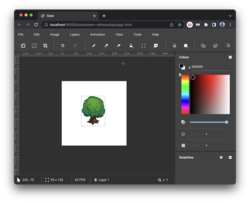Programming Leftovers
-
Porting Slate to Qt for WebAssembly
The 6.4 release makes Qt for WebAssembly a supported platform. In this post we'll take a look at how to port an existing application to this platform, using the Slate pixel art drawing app as an example. Slate is a Qt Quick-based application which means Qt Quick will be the focus of this blog post, however Qt for WebAssembly supports Qt Widgets as well and a lot should carry over to that module.
-
Why you should consider Rexx for scripting
How do you design a programming language to be powerful yet still easy to use? Rexx offers one example. This article describes how Rexx reconciles these two seemingly contradictory goals.
-
How to fix issues caused by reusing Go error variables
This article discusses issues caused by reusing error variables in Go code. I will begin by illustrating the problem with a fictional company called ACME Corporation and its software engineer Wile E. Then I will present trivial examples to reveal the problem and how to avoid it.
-
Open source DevOps tools in a platform future | Opensource.com
The open source roots of DevOps tools are undeniable, even with a prediction that the global DevOps market will reach $17.8 billion by 2026. The changing world of work, security, and compliance concerns, along with venture capital firms, are pushing the market to DevOps platforms where development teams can access a complete end-to-end DevOps toolchain in the cloud.
-
If You Aren’t Automating Testing, You Aren’t Doing DevSecOps - IT Jungle
If you are going to automate application development and operations like a hyperscaler, it is not as simple as moving code to a Git repository and then you are done. Security is critical to DevOps – so much that people are now calling it DevSecOps to highlight that fact – and testing is the only way of ensuring security.
So, again, if you aren’t automating your testing, then you are not really doing DevOps in an automated way like the Googles and Facebooks and Amazons of the world, and like you should be able to do because the tools existing for you – even in the IBM i market – do automate all aspects of the application pipeline.
-
How to Create and Manipulate SQL Database with Python [Ed: This is a spammy embedded link in there, but the post seems OK other than that]
Python has become a popular language in recent years. Its flexibility, with its ease of learning and use, makes it very appealing to newbie and professional SQL programmers alike.
Structured Query Language (SQL) has become a staple in database technology. The most commonly used Relational DataBase Management Systems (RDBMS) today, such as MySQL, PostgreSQL, Microsoft’s SQL Server, and Oracle, all use SQL to manipulate their databases. Do note that although they all use SQL as their base query language, they are not all equal. Queries for a specific database will likely need slight alterations to function in other databases.

